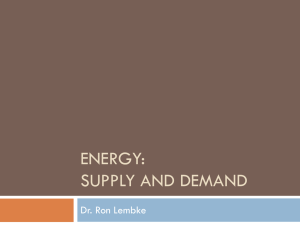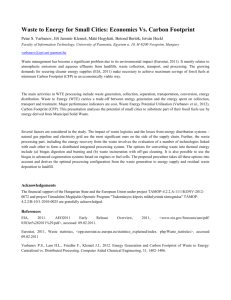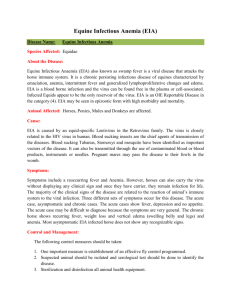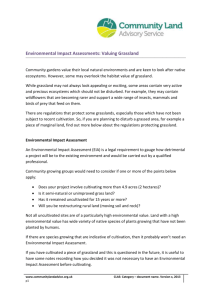File - Meagan Ishee
advertisement
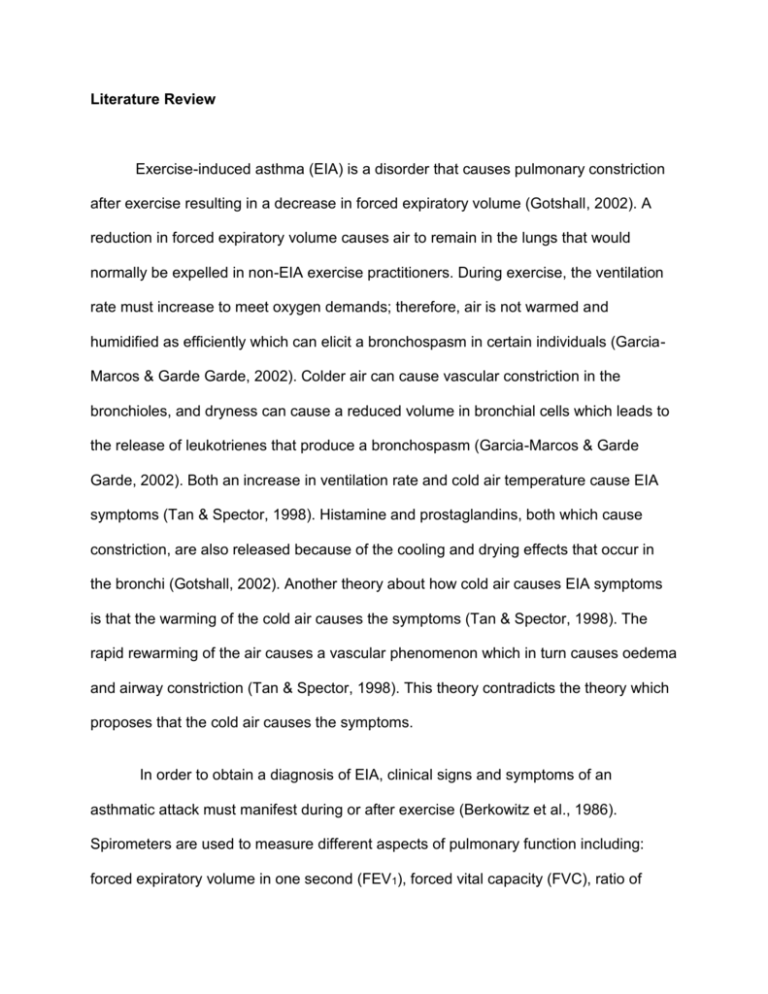
Literature Review Exercise-induced asthma (EIA) is a disorder that causes pulmonary constriction after exercise resulting in a decrease in forced expiratory volume (Gotshall, 2002). A reduction in forced expiratory volume causes air to remain in the lungs that would normally be expelled in non-EIA exercise practitioners. During exercise, the ventilation rate must increase to meet oxygen demands; therefore, air is not warmed and humidified as efficiently which can elicit a bronchospasm in certain individuals (GarciaMarcos & Garde Garde, 2002). Colder air can cause vascular constriction in the bronchioles, and dryness can cause a reduced volume in bronchial cells which leads to the release of leukotrienes that produce a bronchospasm (Garcia-Marcos & Garde Garde, 2002). Both an increase in ventilation rate and cold air temperature cause EIA symptoms (Tan & Spector, 1998). Histamine and prostaglandins, both which cause constriction, are also released because of the cooling and drying effects that occur in the bronchi (Gotshall, 2002). Another theory about how cold air causes EIA symptoms is that the warming of the cold air causes the symptoms (Tan & Spector, 1998). The rapid rewarming of the air causes a vascular phenomenon which in turn causes oedema and airway constriction (Tan & Spector, 1998). This theory contradicts the theory which proposes that the cold air causes the symptoms. In order to obtain a diagnosis of EIA, clinical signs and symptoms of an asthmatic attack must manifest during or after exercise (Berkowitz et al., 1986). Spirometers are used to measure different aspects of pulmonary function including: forced expiratory volume in one second (FEV1), forced vital capacity (FVC), ratio of FEV1 to FVC (FEV1%), peak expiratory flow (PEF), and forced expiratory flow at 25–75% of FVC (FEF25-75%) (Manoharan & Swaminathan, 2009). Berkowitz et al. used a spirometer to measure FEV1, FVC, FEV25-75%, and PEF as a means of determining pulmonary function in 18 asthmatic children (Berkowitz et al., 1986). A spirometric measurement with a decrease in FEV1 a minimum of 10% to 20% post-exercise would indicate EIA (Joyner, 2006 & Berkowitz et al., 1986). A study conducted by Berkowitz et al. determined if the participants had EIA by noting a decrease in post-exercise FEV1 of 20% or greater compared to pre-exercise spirometry measurements during the pretesting assessment (Berkowitz et al., 1986). Some clinical signs and symptoms of acute asthma include: dyspnea, coughing, wheezing, and chest tightness (Tillie-Leblond et al., 2009). Individuals may experience EIA differently by having a unique combination of these signs and symptoms. The individual athlete should learn to recognize their own symptoms to better manage their EIA. Some of the asthma symptoms that EIA athletes should recognize, especially during or after exercise, are: chest tightness, coughing, dyspnea, wheezing, and inability to catch one’s breath (Miller et al., 2005). Athletes will often induce a refractory period which allows them to perform during the athletic event. EIA often occurs by 3 to 8 minutes of exercise (Tan & Spector, 1998). Asthma symptoms peak within 8 to 15 minutes after exercise, and most EIA patients experience a recovery phase that occurs within 60 minutes after the initial exercise ends (Tan & Spector, 1998). Some EIA athletes have experience symptoms that occur 4 to 6 hours after an exercise session, but this phenomenon is rare (Tan & Spector, 1998). If another exercise session occurs after the primary one, EIA patients show fewer symptoms, or a refractory period (Tan & Spector, 1998). The manipulation of exercise techniques is another nonpharmacological intervention that is used to treat EIA. When an exercise is repeated within four hours of the initial exercise, EIA symptoms are significantly less that during the initial period (Mickleborough, Lindley, & Turner, 2007). By triggering a refractory period, athletes will be able to compete with better pulmonary function. EIA athletes can capitalize on this refractory period by timing the refractory period to occur during their main athletic event. As a result, the EIA athlete will have an improved performance during the event. The prevalence rate of EIA is about 90% in asthmatics and as high as 50% in certain athletes (Parsons, 2008). Approximately 14% of the general population, who are non-asthmatics, suffers from EIA (Mickleborough, 2000). A significant part of the population suffers from EIA as proven by such high prevalence rates. Both pharmacological and non-pharmacological interventions are used in the treatment and prevention of EIA. Medication can be prescribed as a daily preventative long-acting treatment or a prophylactic short-term precautionary measure. Nonpharmacological techniques that can be used are the modification of breathing techniques, diet, and warm-ups. The four common classes of medications used to prevent EIA are: inhaled corticosteroids, cromones, short- and long-acting β2- adrenergic agonists, and antileukotrienes (Garcia-Marcos & Garde Garde, 2002). Salbutamol, also known as albuterol, is a short-acting β2- adrenergic agonist that begins to take effect within about fifteen or twenty minutes and last about four to six hours (Garcia-Marcos & Garde Garde, 2002).The majority of athletes use a type of short-acting β2- adrenergic agonists, such as albuterol, about fifteen minutes prior to physical activity to prevent EIA symptoms (Gotshall, 2002). A study conducted by Mickleborough, Lindley, and Turner found that the use of an albuterol inhaler prior to exercise caused post-exercise FEV to increase by 27%. (Mickleborough, Lindley, & Turner, 2007). One non-pharmacological intervention that EIA patients can implement is the management of their diet. Since excessive sodium and chloride can exacerbate EIA symptoms, dietary salt intake should be restricted in EIA patients (Garcia-Marcos & Garde Garde, 2002). A study conducted by Mickleborough et al. in 2000 found that the asthmatic participants in the study who were placed on a low sodium diet, 958 milligrams per day, for two week had an improvement in forced expiratory volume and flow. In the same study, asthmatic participants placed of the high sodium diet, 8133 milligrams per day, saw a decrease in pulmonary function; therefore, salt exacerbates asthma symptoms (Mickleborough et al., 2000). Studies lead researchers to believe that dietary sodium can cause the production of leukotrienes, but more research must be conducted before these conclusions can be confirmed (Gotshall, 2002). Caffeine helps relax smooth muscle in the bronchi; therefore, moderate amounts of caffeine should be consumed before physical activity to help dilate vessels in the lungs (Mickleborough & Gotshall, 2003). Approximately three cups of strong coffee contain the amount of caffeine needed to cause a significant decrease in FEV1 (Mickleborough & Gotshall, 2003). Breathing technique is a key element in ensuring that the muscles are oxygenated efficiently. If EIA athletes are not breathing properly, their symptoms will continue to worsen. Miller et al. states that the NATA position statement recommends nose breathing for asthmatic athletes because this technique warms air therefore decreasing the inflammation response (2005). Although nose breathing is not practical during high intensity exercise, EIA athletes should be encouraged to practice nose breathing whenever possible. This type of breathing slows down the ventilation rate and helps to warm the inspired air. These factors should be considered when treating EIA. First, the individual’s symptoms should be evaluated to determine their individual triggers and the severity of their symptoms. Then, an individualize treatment plan should be created which best fits the individual’s symptoms. EIA can be managed effectively with the appropriate treatment plan. Works Cited Berkowitz, R., Schwartz, E., Bukstein, D., Grunstein, M., Chai, H. (1986). Albuterol protects against exercise-induced asthma longer than metaproterenol sulfate. Pediatrics, 77(2), 173-177. Garcia-Marcos, L, & Garde Garde, J. (2002). Exercise-induced asthma, its treatment and the athlete. International SportMed Journal, 3(2), 1-10. Gotshall, R. (2002). Exercise-induced bronchoconstriction. Drugs, 62(12), 1725-1739. Manoharan, S. & Swaminathan, R. (2009). Prediction of forced expiratory volume in normal and restrictive respiratory functions using spirometry and self-organizing map. Journal of Medical Engineering & Technology, 33(7), 538-543. Mickleborough, T., Lindley, M., Turner, L. (2007). Comparative effects of a high-intensity interval warm-up and salbutamol on the bronchoconstrictor response to exercise in asthmatic athletes. International Journal of Sports Medicine, 28, 456-462. Mickleborough, T., Cordain, L., Gotshall R., & Tucker, A. (2000). A low sodium diet improves incidences of pulmonary function in exercise-induced asthma. Journal of Exercise Physiology, 3(2). Retrieved from: http://web.ebscohost.com.logon.lynx.lib.usm.edu/ehost/pdfviewer/pdfviewer?sid= 96a6fe0f-19bd-4b92-9241-68e36816ab9b%40sessionmgr15&vid=1&hid=12. Miller, M., Weiler, J., Baker, R., Collins, J., D’Alonzo, G. (2005). National Athletic Trainers Association position statement: management of asthma in athletes. Journal of Athletic Training, 40(3), 224-245. Parsons, J., baran, C., Phillips, G., Jarjoura, D., Kaeding, C., Bringardner, B., Wadley, G., Marsh, C., Mastronarde, J. (2008). Airway inflammation in exercise-induced bronchospasm occurring in athletes without asthma. Journal of Asthma, 45, 363367. Tan, R. & Spector, S. (1998). Exercise-Induced Asthma. Sports Medicine, 25(1), 1-6. Tillie-Leblond, I., Montani, D., Crestani, B., de Blic, J., Humbert, M., Tunon-de-Lara, M., Magnan, A.,… Chanez, P. (2009). Relation between inflammation and symptoms in asthma. Allergy, 64, 354-367.



